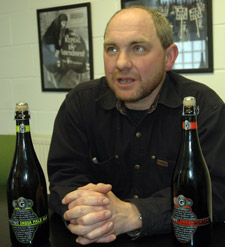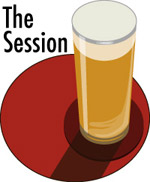 Another beautifully written tribute to Michael Jackson, worth your time while you make plans to attend the National Toast in his honor on Sunday.
Another beautifully written tribute to Michael Jackson, worth your time while you make plans to attend the National Toast in his honor on Sunday.
Alastair Hook, brewmaster at Meantime Brewing in Greenwich, used Jackson’s writing to plot out a tour of Europe more than 20 years ago that set him on the course to becoming a brewer: “It showed me European history through a beer glass, and woke within me a desire to create great beer for a British populace that was being sold short by the keg revolution and ersatz brewed-under-licence fizz.”
Because the Meantime site uses frames you’ll need to navigate to what he posted the day after the Beer Hunter died. From the front page click on News and then the top story in the box. It begins:
“Michael Jackson died yesterday and for me the greatest sadness of this loss is that despite him achieving all he wanted to achieve in the United States his legacy to the British brewing industry will remain questioned, and his passing will not generate the emotional earthquakes that it will in the United States. This is a tragedy, for it is the people of his homeland that owe a huge debt to Michael for is unwavering and selfless pursuit of the celebration of beer.
“For me he was the great inspiration, he turned base metal in to gold with his writing. Not only was it full of articulate observation of the character of beer itself but it wove in to its nature the history of the peoples and society that created it. He brought beer alive by showing to us all that what was present in a glass was more than just a liquid, it was a story, a triumph and would always provide a moment to savour, to uplift and to foster fun and reverence.
“His honesty and forthright appraisal with what was wrong in the British brewing fraternity was too much for many, and shunned by his own homeland he was equally emphatically celebrated as a hero in the New World. In the US he was the first object of attention for the ‘Beer Groupie’! To a large extent what he achieved in the US – bastion of the bland circa 1980, the most creative brewing fraternity in the world now – will indirectly help shake his homeland into the creative vein he always wanted to see. American micro-brewing has spawned a new generation of young brewers in the UK who refuse to accept blandness and mediocrity, and it is these people who owe the greatest debt to The Beer Hunter.”
 No I don’t suddenly covet the beers of BrewDog because they are getting good marks at
No I don’t suddenly covet the beers of BrewDog because they are getting good marks at  I think I put on five pounds this week just reading or thinking about food and beer together.
I think I put on five pounds this week just reading or thinking about food and beer together. Local drinkers say they can
Local drinkers say they can